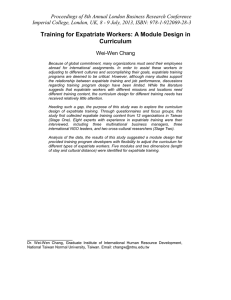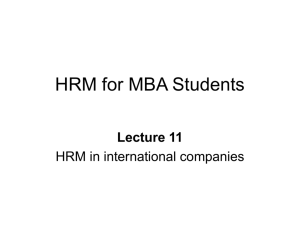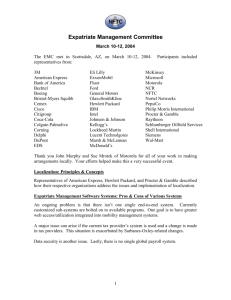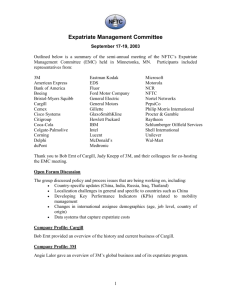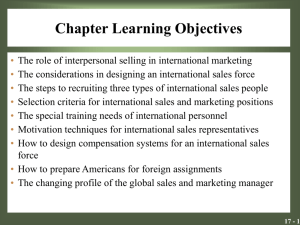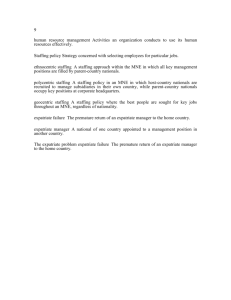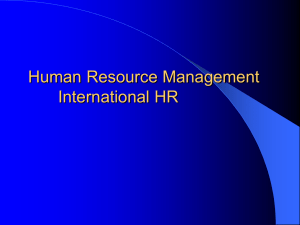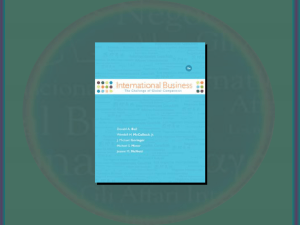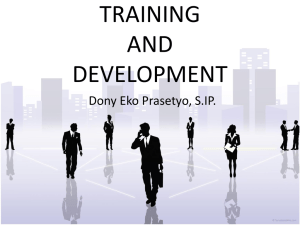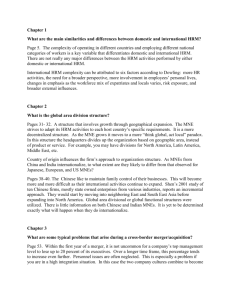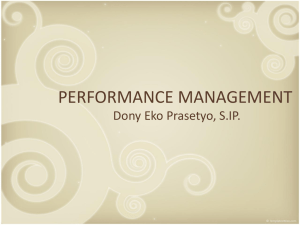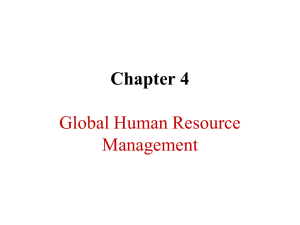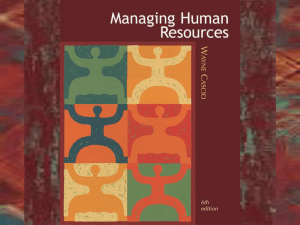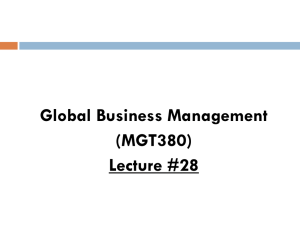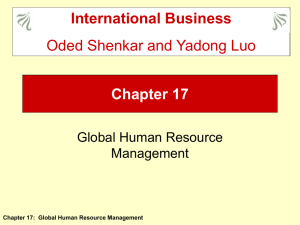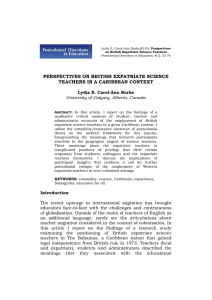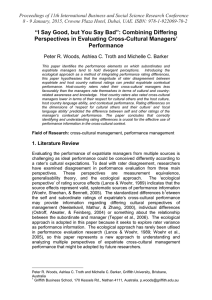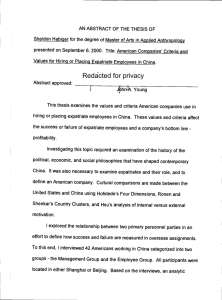International Human Resource Development: Expatriate Training
advertisement
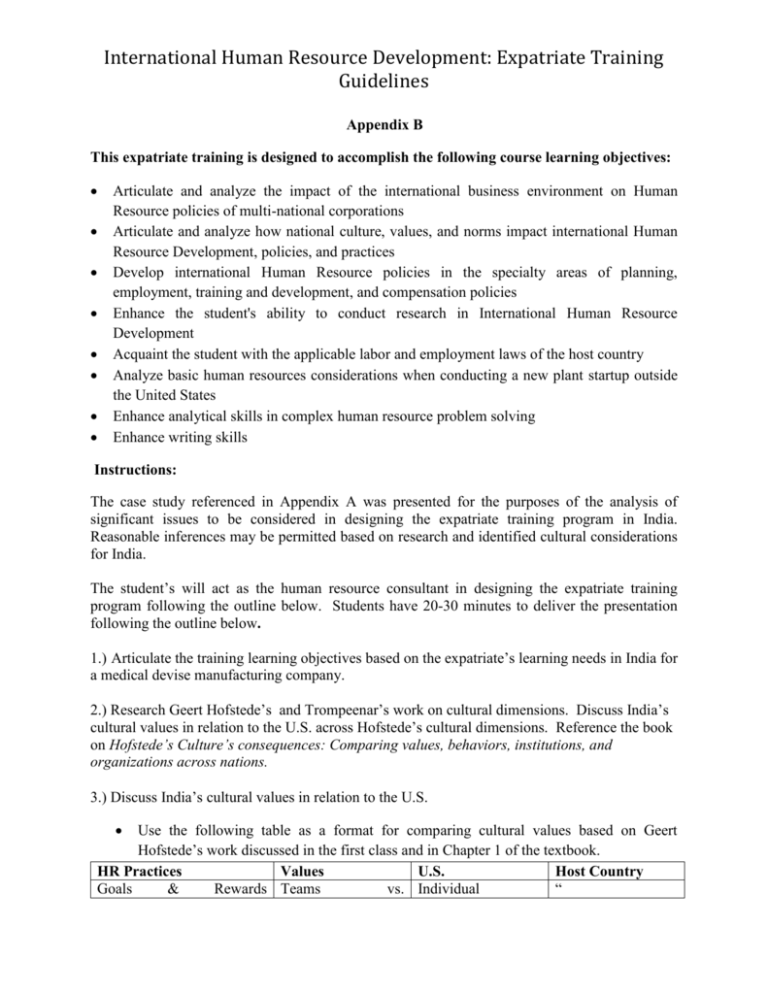
International Human Resource Development: Expatriate Training Guidelines Appendix B This expatriate training is designed to accomplish the following course learning objectives: Articulate and analyze the impact of the international business environment on Human Resource policies of multi-national corporations Articulate and analyze how national culture, values, and norms impact international Human Resource Development, policies, and practices Develop international Human Resource policies in the specialty areas of planning, employment, training and development, and compensation policies Enhance the student's ability to conduct research in International Human Resource Development Acquaint the student with the applicable labor and employment laws of the host country Analyze basic human resources considerations when conducting a new plant startup outside the United States Enhance analytical skills in complex human resource problem solving Enhance writing skills Instructions: The case study referenced in Appendix A was presented for the purposes of the analysis of significant issues to be considered in designing the expatriate training program in India. Reasonable inferences may be permitted based on research and identified cultural considerations for India. The student’s will act as the human resource consultant in designing the expatriate training program following the outline below. Students have 20-30 minutes to deliver the presentation following the outline below. 1.) Articulate the training learning objectives based on the expatriate’s learning needs in India for a medical devise manufacturing company. 2.) Research Geert Hofstede’s and Trompeenar’s work on cultural dimensions. Discuss India’s cultural values in relation to the U.S. across Hofstede’s cultural dimensions. Reference the book on Hofstede’s Culture’s consequences: Comparing values, behaviors, institutions, and organizations across nations. 3.) Discuss India’s cultural values in relation to the U.S. Use the following table as a format for comparing cultural values based on Geert Hofstede’s work discussed in the first class and in Chapter 1 of the textbook. HR Practices Values U.S. Host Country Goals & Rewards Teams vs. Individual “ International Human Resource Development: Expatriate Training Guidelines (compensation) Goals & Rewards Individual Short-Term Long-Term vs. Staffing List others List others 4) Describe the recruiting and selection strategies for attracting the needed skills and supervisory personnel in India. Refer to the Recruitment and Selection Chapters in the Anthony et al. textbook or another source. Also consider the class discussion on The coffee-machine system: How international selection really works (Harris & Brewster, 1999) and the Typology of international manager selection systems. 5.) Identify the basic government and employment laws in India that will affect your company’s policies for which compliance is required. 6.) Identify the basic content of the employee handbook describing company policies i.e. communication, dress, and acceptable norms. Research some examples of employee handbooks to inform your response. 7.) Identify the specific sources of information in India that will be used to develop the wage and benefits packages for hourly and salaried personnel according to the desired compensation strategies. Reference a specific compensation strategy from the Compensation Chapter from the Anthony et al. textbook or another source. 8.) Outline the essential elements of the expatriate contract. You can use the following table to track your team’s progress. Activity Form Teams Select a country Research Hofstede’s cultural dimensions for that particular country. What could you incorporate into your paper from each class discussion? Describe the organizational structure. The training program Team Member Accountability Due Date Status International Human Resource Development: Expatriate Training Guidelines should discuss the organizational structure so that the expatriate understands how decisions are made, authority, and control, understand reporting relationships, and how to work with HR. You can create a pseudo name for your MNE or use an actual company. What is HR’s function in the foreign production stage of internationalization? Describe the organizational structure. The training program should discuss the organizational structure so that the expatriate understands how decisions are made, authority, and control, understand reporting relationships, and how to work with HR.
